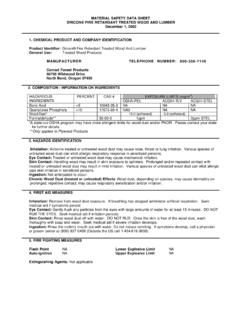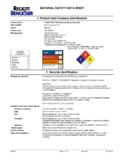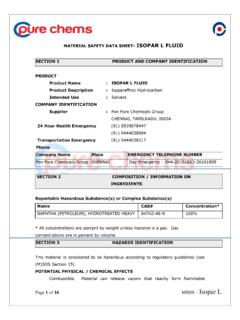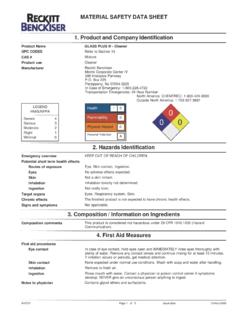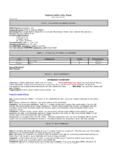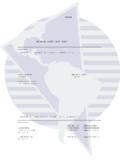Transcription of MATERIAL SAFETY DATA SHEET R-123 I SECTION 1 - …
1 MATERIAL SAFETY data SHEET R-123 I SECTION 1 - company identification /CHEMICAL product I Recycler: Refrigerants, Inc. Prepared by: Refrigerants, Inc. 2575 W. Barberry Pl. INFOTRAC Denver, CO 80204 EMERGENCY RESPONSE # (800) 535-5053 303-629-1222 Date Prepared: 10-14-98 Corporate MSDS Number: MSDSRI23 Formula: CHCl2CF3 CAS Name: 2, 2-dichloro-l, I, I-trifluoroethane (HCFC-123) I SECTION 2 COMPOSITION/INFORMATION ON INGREDIENTS MATERIAL CAS Number % * ETHANE, 2,2-DICHLORO-I, I, 1- TRlCHLORO (HCFC 123) 306-83-2 100 * Disclosure as a toxic chemical is required under SECTION 313 of Title 11I of the Superfund Amendments and Reauthorization Act of 1986 and 40 CFR part 372.
2 I SECTION 3 - PHYSICAL/CHEMICAL CHARACTERISTICS Boiling Point : C ( F) @ 760 mm Hg pH Vapor Pressure : 13 psia at 25 deg C (77 deg F) Odor Vapor Density : (Air = I) Form Density : g/cm3 at 25 deg C (77 deg F) % Volatiles Evaporation Rate : <I (CCI4=1) Color Solubility in Water : WT% @25 C (77 deg F) I SECTION 4 - FIRE FIGHTING MEASURES Flammable Properties Flash Point : None Method Flammable limits in Air, % by volume LEL : None UEL: None Fire and Explosion Hazards: Use water spray or fog to cool containers.
3 Drums may rupture under fire conditions. Decomposition may occur. Self-contained breathing apparatus (SCBA) is required if cylinders rupture or discharge under fire conditions. Extinguishing Media: As appropriate for combustibles in area. I SECTION 5 - HAZARDS identification Potential Health Effects: Inhalation of high concentrations of vapor is harmful and may cause heart irregularities, unconsciousness, or death. Intentional misuse or deliberate inhalation may cause death without warning.
4 Vapor reduces oxygen available for breathing and is heavier than air. Liquid contact can cause frostbite. May cause eye irritation. Health Effects: Human health effects of overexposure by eye contact with the vapor may include eye irritation with discomfort, tearing, or blurring of vision. Skin contact with the liquid may cause frostbite. Inhalation of the vapors may cause temporary nervous system depression with anesthetic effects such as dizziness, headache, confusion, incoordination, and loss of consciousness; temporary alteration of the heart's electrical activity with irregular pulse, palpitations, or inadequate circulation, or the effects of exclusion of oxygen with grossly excessive exposures (>2%).
5 Carcinogenicity Information None of the components present in this MATERIAL at concentrations equal to or greater than % are listed by IARC, NTP, OSHA or ACGIH as a carcinogen. EMERGENCY AND FIRST AID PROCEDURES: Inhalation: If inhaled, immediately remove to fresh air. Keep person calm. If not breathing, give artificial respiration. If breathing is difficult, give oxygen. Call a physician. Skin Contact: In case of contact, flush skin with water. Treat for frostbite if necessary by gently warming affected area.
6 Call a physician. Eye Contact: In case of contact, immediately flush eyes with water for at least 15 minutes. Call a physician. Ingestion: MATERIAL poses an aspiration hazard. If swallowed, do not induce vomiting. Immediately give 2 glasses of water. Never give anything by mouth to an unconscious person. If vomiting occurs naturally, have victim lean forward to reduce the risk of aspiration. Consult a physician if necessary. Notes to Physician: : Neutral : Slight ethereal : Liquid : 100WT% : Clear, Colorless THIS MATERIAL MAY MAKE THE HEART MORE SUSCEPTIBLE TO ARRHYTHMIAS.
7 Because of a possible disturbance of cardiac rhythm, catecholamine drugs, such as epinephrine, should only be used with special caution in situations of emergency life support. I SECTION 6- STABILITY AND REACTIVITY I Chemical Stability: MATERIAL is stable. However, avoid open flames and high temperatures. Incompatibility with other Materials: Incompatible with alkali or alkaline earth metals - powdered AI, Zn, Be, etc. Polymerization: Polymerization will not occur. Other hazards Decomposition: Decomposition products are hazardous.
8 R-123 Refrigerant can be decomposed by high temperatures (open flames, glowing metal surfaces, etc.) forming hydrochloric and hydrofluoric acids and possibly carbonyl halides. I SECTION 7- CONTROL AND PROTECTIVE MEASURES I Engineering Controls: Normal ventilation for standard manufacturing procedures is generally adequate. Keep container tightly closed. Local exhaust should be used when large amounts are released. Mechanical ventilation should be used in low or enclosed places.
9 Personal Protective Equipment: Impervious gloves and chemical splash goggles should be used when handling liquid. Under normal manufacturing conditions, no respiratory protection is required when using this product . Self-contained breathing apparatus (SCBA) is required if a large release occurs. Exposure Guidelines "SUVA"-123 Refrigerant PEL (OSHA): None established TL V (ACGIH) : None established I SECTION 8- HANDLING/STORAGE/WASTE DISPOSAL I Waste disposal method: Comply with Federal, State, and local regulations.
10 Reclaim by distillation or remove to a permitted waste facility. Handling: Avoid breathing vapors and liquid contact with the skin and eyes. Use with sufficient ventilation to keep employee exposure below recommended limits. Do not allow product to contact open flame or electrical heating elements because dangerous decomposition products may form. Storage: Clean, dry area. Do not heat above 52 deg C (126 deg F). Accidental Release Measures: Ventilate area, especially low or enclosed places where heavy vapors might collect.
